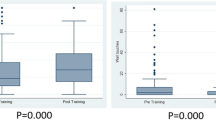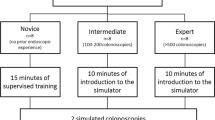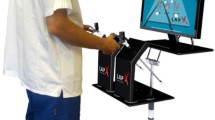Abstract
Background
Although virtual reality (VR) simulators can be used ability to objectively assess skills in endoscopy, the evaluation is solely quantitative. We have developed a novel method for the objective assessment of technical skills in lower gastrointestinal (GI) endoscopy that incorporates qualitative as well as quantitative measures.
Methods
We developed a virtual endoscopy suite by deconstructing the VR simulator to enable a more realistic and ergonomic placement of the monitor. Trainee endoscopists with varying levels of experience performed the case 4 task of the simulator. Ten essential components of endoscopic performance were rated on a five-point Likert scale (global score) by three independent observers. These observers viewed two videos (one showing scope handling and the other showing the monitor image), which were synchronized and played simultaneously.
Results
The study population comprised six experts (group 1, >200 procedures), seven subjects with intermediate experience (group 2, 20–80 procedures), and seven novices (group 3, 1–10 procedures). The global score was found to discriminate the level of skills across all three groups (p < 0.001). There were significant differences between groups 1 and 2 (p = 0.003) and groups 2 and 3 (p = 0.004). There was a significant correlation between the global score and the percentage of red-out (without vision) as recorded by the simulator (correlation coefficients = -0.61, p = 0.004).
Conclusion
This novel method for the assessment of technical skills in lower GI endoscopy has construct validity and high interrater reliability.




Similar content being viewed by others
References
IJ Adams Z Ali AJ Shorthouse (2001) ArticleTitleInadequacy of colonoscopy revealed by three-dimensional electromagnetic imaging Dis Colon Rectum 44 978–983 Occurrence Handle11496078
R Bisschops A Wilmer J Tack (2002) ArticleTitleA survey of gastroenterology training in Europe Gut 50 724–729 Occurrence Handle10.1136/gut.50.5.724 Occurrence Handle11950824
OW Cass (1993) ArticleTitleObjective evaluation of endoscopy skills during training Ann Intern Med 118 40–44 Occurrence Handle8416157
OW Cass (1999) ArticleTitleTraining to competence in gastrointestinal endoscopy: a plea for continuous measuring of objective endpoints. Endoscopy 31 751–754 Occurrence Handle10.1055/s-1999-148 Occurrence Handle10604620
OW Cass ML Freeman J Cohen G Zuckerman J Watkins J Nord GR Locke D Jensen D Diehl M Cerulli K Lycke M Fennerty S Edmundowicz K Etzkorn F Al-Kawas D Cave G Lehman InstitutionalAuthorName(Aces study group) (1998) ArticleTitleAcquisition of competency in endoscopy skills (ACES) during training: a multi-centre study [Abstract]. Gastrointest Endosc 43 308
HG Colt SW Crawford O Galbraith (2001) ArticleTitleVirtual reality bronchoscope simulation: a revolution in procedural training Chest 120 1333–1339 Occurrence Handle10.1378/chest.120.4.1333 Occurrence Handle11591579
A Cuschieri N Francis J Crosby GB Hanna (2001) ArticleTitleWhat do master surgeons think of surgical competence and revalidation Am J Surg 182 110–116 Occurrence Handle10.1016/S0002-9610(01)00667-5 Occurrence Handle11574079
G Dafnis F Granath Pahlman H Hannuksela A Ekbom P Blomqvist (2001) ArticleTitleThe impact of endoscopists experience and learning curves and interendoscopist variation on colonoscopy completion rates Endoscopy 33 511–517 Occurrence Handle10.1055/s-2001-14964 Occurrence Handle11437045
V Datta S Mackay M Mandalia A Darzi (2001) ArticleTitleThe use of electromagnetic motion tracking analysis to objectively measure open surgical skill in the laboratory-based model J Am Coll Surg 193 479–485 Occurrence Handle10.1016/S1072-7515(01)01041-9 Occurrence Handle11708503
V Datta M Mandalia S Mackay A Darzi (2002) ArticleTitleThe PreOp Flexible Sigmoidoscopy Trainer : validation and early evaluation of a virtual reality based system Surg Endosc 16 1459–1463 Occurrence Handle10.1007/s00464-002-9014-4 Occurrence Handle12042913
ML Freeman (2001) ArticleTitleTraining and competence in gastrointestinal endoscopy Rev Gastroenterol Disord 1 73–86 Occurrence Handle12120177
RL Kneebone D Nestel K Moorthy P Taylor S Bann Y Munz A Darzi (2003) ArticleTitleLearning the skills of flexible sigmoidoscopy — the wider perspective Med Educ 37 IssueIDSuppl 1 50–58 Occurrence Handle10.1046/j.1365-2923.37.s1.2.x Occurrence Handle14641639
J MacDonald J Ketchum RG Williams LQ Rogers (2003) ArticleTitleA lay person versus a trained endoscopist Surg Endosc 17 896–898 Occurrence Handle10.1007/s00464-002-8559-6 Occurrence Handle12632138
JB Marshall (1995) ArticleTitleTechnical proficiency of trainees performing colonoscopy: a learning curve Gastrointest Endosc 42 287–291 Occurrence Handle8536893
JB Marshall DN Brown (1996) ArticleTitlePhotodocumentation of total colonoscopy How successful are endoscopists? Do reviewers agree? Gastrointest Endosc 44 423–428
JA Martin G Regehr R Reznick H MacRae J Murnaghan C Hutchison M Brown (1997) ArticleTitleObjective Structured Assessment of Technical Skill (OSATS) for surgical residents Br J Surg 84 273–278 Occurrence Handle10.1046/j.1365-2168.1997.02502.x Occurrence Handle9052454
G Regehr H MacRae RK Reznick D Szalay (1998) ArticleTitleComparing the psychometric properties of checklists and global rating scales for assessing performance on an OSCE-format examination Acad Med 73 993–997 Occurrence Handle9759104
RE Sedlack JC Kolars (2003) ArticleTitleValidation of a computer-based colonoscopy simulator Gastrointest Endosc 57 214–218 Occurrence Handle12556787
SG Shah S Thomas-Gibson JC Brooker N Suzuki CB Williams C Thapar BP Saunders (2002) ArticleTitleUse of video and magnetic endoscope imaging for rating competence at colonoscopy: validation of a measurement tool Gastrointest Endosc 56 568–573 Occurrence Handle10.1067/mge.2002.128133 Occurrence Handle12297780
LW Traverso (2002) ArticleTitleGuidelines for granting of privileges for gastrointestinal endoscopy: focus on outcomes, not number of procedures performed. Surg Endosc 16 229 Occurrence Handle10.1007/s00464-001-0072-9 Occurrence Handle11967668
ML Tuggy (1998) ArticleTitleVirtual reality flexible sigmoidoscopy simulator training: impact on resident performance. J Am Board Fam Pract 11 426–433 Occurrence Handle9875997
SD Wexner JE Garbus JJ Singh InstitutionalAuthorNamethe SAGES colonoscopy outcomes study group (2001) ArticleTitleA prospective analysis of 13,580 colonoscopies: reevaluation of credentialing guidelines Surg Endosc 15 251–261 Occurrence Handle10.1007/s004640080147 Occurrence Handle11344424
Acknowledgments
We thank Simon Bann and Roger Kneebone for help with the concept of the virtual endoscopy suite and the development of ICASE, as well as Benny Lo and G. Z. Yang from the Department of Computing Technology for help with the clinical data recorder. We are grateful to Lee Edwards for help and advice with the running and maintenance of the clinical data recorder.
Author information
Authors and Affiliations
Corresponding author
Rights and permissions
About this article
Cite this article
Moorthy, K., Munz, Y., Orchard, T.R. et al. An innovative method for the assessment of skills in lower gastrointestinal endoscopy. Surg Endosc 18, 1613–1619 (2004). https://doi.org/10.1007/s00464-004-9002-y
Received:
Accepted:
Published:
Issue Date:
DOI: https://doi.org/10.1007/s00464-004-9002-y




